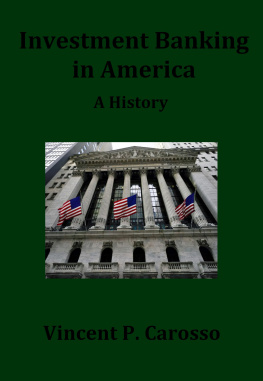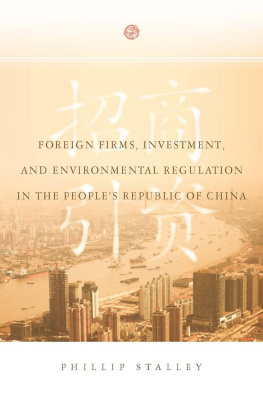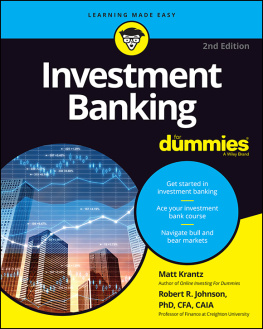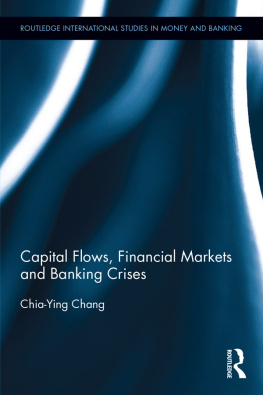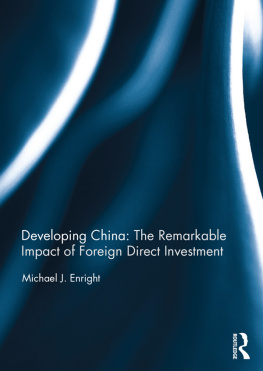Investment Banking in America
A History
Vincent P. Carosso
Harvard University Press
Cambridge, Massachusetts
1970
Harvard Studies in Business History
XXV
Edited by Ralph W. Hidy
Isidor Strauss Professor of Business History
Graduate School of Business Administration
George F. Baker Foundation
Harvard University
Investment Banking in America: A History
Vincent P. Carosso
Research Associates
Marian V. Sears
Irving Katz
1970 by the President and Fellows of Harvard College
Library of Congress Catalog Card Number 1099315
SBN 674465741
For Rose and Steven
Contents
Editors Introduction
With this study of the investment banker in the twentieth century a long step has been taken toward filling a gap in historical knowledge. Both general and economic historians have long known the major features of investment banking history in the United States up to World War I. Early in the century the behavior of the fraternity, being the subject of federal investigation, received much popular and semipopular analysis. By World War II, several authors, through articles and books of varying quality, had provided more comprehensive and better analyzed data on investment bankers from Nathaniel Prime to J. P. Morgan, the elder. Clearly needed, however, was an objective appraisal of the changing role of investment banking in the United States in the twentieth century.
During the five years after World War II historians at the Harvard Business School made some moves toward meeting the need. In discussions with men in a few firms Professor Henrietta M. Larson probed the possibilities of raising funds and of gaining access to the records of several private banking houses, but pressure of other obligations inhibited anything more than preliminary inquiries; she had to abandon an interest stimulated by her study of Jay Cooke. Although Professor Thomas R. Navin and Miss Marian V. Sears attempted no project covering all or major parts of the twentieth century, they did do some meaningful research and writing on segments of the topic. And later in the 1950s, Professor Barry Supple wrote an article on GermanJewish bankers in the United States in the nineteenth century.
Given such concern, it is not surprising that the historians at the School were quite interested when Kidder, Peabody & Co., Inc. suggested that it underwrite a scholarly history of the firm. After some discussion the topic for study was altered to the history of American investment banking in the twentieth century, data from the history of Kidder, Peabody & Co. to be used when appropriate. The School engaged Professor Vincent P. Carosso of New York University, at one time Business History Fellow at the School, to conduct the research and write the proposed book. It was understood that his work, both research and writing, would be carried on under my editorship. The views and interpretations expressed in the book were to be, and are, the authors alone.
Much discussion has revolved around shaping the questions to be answered and hypotheses to be tested. The major emphasis has been placed on the process of change through interaction of investment banks, including Kidder, Peabody & Co., with their environment. Special attention has been accorded adjustments and reactions of men and firms to shifts in the supply of investment funds, in the structure and size of the demand for them, and in public attitudes as well as actions of government agencies, both state and federal. Although three chapters deal with developments prior to 1900, the focus of the book is on the twentieth century. The study ends with an analysis of the extent of alteration in the structure of investment banking, in its function, and in the ways of performing the function. Overall, this provides an illustration of the process of change through interaction between business in general and the political, economic, and social world in which businessmen live and operate.
Personally, I am deeply grateful to several people for their aid in bringing the work to completion. Kidder, Peabody & Co. granted the funds to start the project and opened doors to numerous sources of information. Several executives of the firm critically read the manuscript for factual accuracy but suggested no changes in interpretation. The Business Schools Division of Research, through Professor Bertrand Fox, then Director of Research, made supplementary grants to assure completion of the study. Professor Fox also applied his meticulous scholarship and deep knowledge of banking and finance to critical evaluation and refining of the manuscripts content and composition. Deepest appreciation goes to the author and his associates, who doggedly devoted several years of their lives, at times under stress from ill health, to producing this history. Together these individuals enable me to realize an ambition to publish a broad industry study in the series sponsored by the historians at the Harvard Business School.
November 1969 Ralph W. Hidy
Authors Preface
As a specialized middleman the investment banker is largely a development of the twentieth century. His job is to serve the users and suppliers of capital by providing the facilities through which savings are channeled into long-term investment. In the nineteenth century this function was performed by merchants, private bankers, and other intermediaries who carried on a large number of services concerned with marketing goods and securities.
The name investment banker itself is of recent general acceptance. Although it was used in England as early as the 1840s by traveling salesmen dealing in American railroad securities, it rarely was employed in the United States before the late 1880s except in reference to dealers in mortgages, western farms, or real estate. The Bankers Magazine adopted the heading Investment Bankers and Brokers in its classified advertisements starting in January 1896; but in 1902, when investment bankers were close to the height of their influence and prestige, Smiths Financial Dictionary, a standard and respected reference work of the day, listed neither investment banker nor investment banking among its numerous entries. The 1902 RandMcNally Bankers Directory, a widely accepted listing of banks and trust companies in the United States, used the heading Investment Banker for New York City but under it failed to include some of Wall Streets outstanding firms, such as Kuhn, Loeb & Co. Eight years later the directory dropped the heading and substituted Investment Securities and Bond Dealers.
In 1912, when the Investment Bankers Association of America (IBA) was established as an offshoot of the American Bankers Association, the organizers were not agreed as to what kinds of firms they should invite to join the new group. The difficulties encountered in establishing criteria of eligibility for membership in this, the first association constituted purely of investment bankers, were very similar to those faced earlier by compilers of bank directories and financial dictionaries. As a result, the IBAs 347 charter members included many commercial banks and trust companies with bond departments performing some investment banking functions, as well as private bankers, brokers, and other dealers in securities.
Functional specialization among financial institutions still was blurred, and there was no agreement on a precise definition of an investment banker. Those engaged in the securities business rarely referred to themselves as such, and the investment banking function was performed by more firms than those specializing exclusively in the buying and selling of securities for resale. Nearly all the major pre-World War I investment houses, including such national leaders as J. P. Morgan & Co., Kuhn, Loeb & Co., and Kidder, Peabody & Co., conducted a general banking business accepting deposits, trading in foreign exchange, issuing letters of credit, dealing in acceptances and commercial paper, and providing other financial services as well as participating in the origination, purchase, underwriting, and distribution of new securities.
Next page
